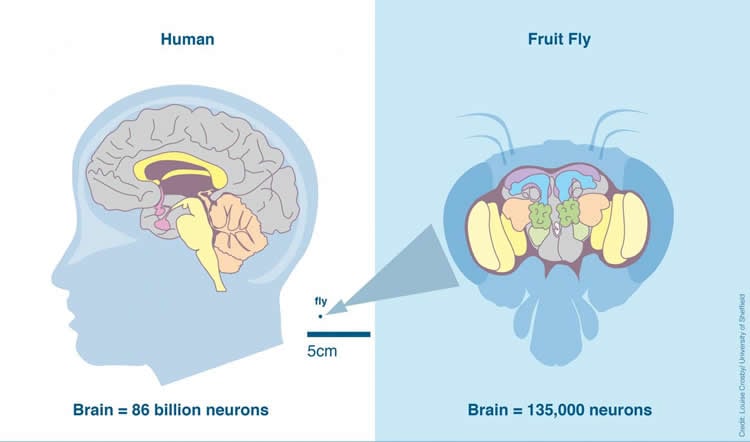Summary: Findings could pave the way for improving retinal implants and restoring vision to those with retinal disorders.
Source: University of Sheffield.
Engineers and neuroscientists have demonstrated for the first time that the cells in the retina carry out key processing tasks.
Engineers and neuroscientists at the University of Sheffield have demonstrated for the first time that the cells in the retina carry out key processing tasks. This could pave the way for improving retinal implants and therefore the sight of thousands of people suffering from retinal disorders.
Up to now, it was thought that the function of these retinal cells, or photoreceptors, was mainly to convert light into electrical signals, from which the brain can interpret images.
However, the new research from Sheffield, published in the journal PLOS ONE, shows that in fruit flies, the photoreceptors believed to be involved in motion detection play a key role in providing visual information about the world around us.
The similarities that exist between responses of human cone photoreceptors and fly photoreceptors suggest that the human eye processes visual signals in a similar way.
If this were true, the research could have significant implications for those developing retinal implants for patients with retinal disorders such as macular degeneration. Age-related macular degeneration is the most common cause of sight loss in the developed world and currently affects more than 600,000 people in the UK.

Retinal implants replace damaged or dead cells by converting light into electrical signals that are sent to the brain. The implants do not restore vision completely but can help patients to detect patterns and shapes.
Daniel Coca, lead researcher from Sheffield’s Department of Automatic Control and Systems Engineering, said: “We think that implementing the processing tasks performed by photoreceptors into retinal implants could help the brain accomplish key tasks such as object recognition and motion detection. This could significantly improve the performance of artificial retinas and therefore the sight of thousands of people suffering from macular degeneration.”
Funding: The research was funded by a grant from the Biotechnology and Biological Sciences Research Council UK (BBSRC) and includes researchers from the University of Sheffield and University of Cambridge.
Source: Charlotte Hurley – University of Sheffield
Image Source: This NeuroscienceNews.com image is credited to Louise Crosby/The University of Sheffield.
Original Research: Full open access research for “Fly Photoreceptors Encode Phase Congruency” by Uwe Friederich, Stephen A. Billings, Roger C. Hardie, Mikko Juusola, and Daniel Coca in PLOS ONE. Published online June 23 2016 doi:10.1371/journal.pone.0157993
[cbtabs][cbtab title=”MLA”]University of Sheffield. “Restoring Vision For Sufferers of Retinal Disorders.” NeuroscienceNews. NeuroscienceNews, 30 June 2016.
<https://neurosciencenews.com/retinal-disorder-vision-restored-4606/>.[/cbtab][cbtab title=”APA”]University of Sheffield. (2016, June 30). Restoring Vision For Sufferers of Retinal Disorders. NeuroscienceNews. Retrieved June 30, 2016 from https://neurosciencenews.com/retinal-disorder-vision-restored-4606/[/cbtab][cbtab title=”Chicago”]University of Sheffield. “Restoring Vision For Sufferers of Retinal Disorders.” https://neurosciencenews.com/retinal-disorder-vision-restored-4606/ (accessed June 30, 2016).[/cbtab][/cbtabs]
Abstract
Fly Photoreceptors Encode Phase Congruency
More than five decades ago it was postulated that sensory neurons detect and selectively enhance behaviourally relevant features of natural signals. Although we now know that sensory neurons are tuned to efficiently encode natural stimuli, until now it was not clear what statistical features of the stimuli they encode and how. Here we reverse-engineer the neural code of Drosophila photoreceptors and show for the first time that photoreceptors exploit nonlinear dynamics to selectively enhance and encode phase-related features of temporal stimuli, such as local phase congruency, which are invariant to changes in illumination and contrast. We demonstrate that to mitigate for the inherent sensitivity to noise of the local phase congruency measure, the nonlinear coding mechanisms of the fly photoreceptors are tuned to suppress random phase signals, which explains why photoreceptor responses to naturalistic stimuli are significantly different from their responses to white noise stimuli.
“Fly Photoreceptors Encode Phase Congruency” by Uwe Friederich, Stephen A. Billings, Roger C. Hardie, Mikko Juusola, and Daniel Coca in PLOS ONE. Published online June 23 2016 doi:10.1371/journal.pone.0157993






